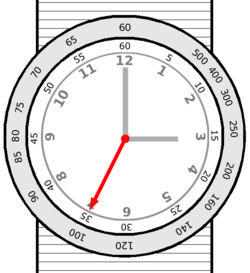Inside Look: Hong Kong’s Counterfeit Watch Trade
I’ve recently found myself working in China for 2 months;
just a stones throw away from Hong Kong, so, as anyone would, I hopped over to
the famous metropolis to spend a few days looking around and maybe at a watch
or two.
Counterfeit goods have been always been around, imitations,
copies, call it what you like - they’re fakes. But one place has always been the place to go for knock off watches
and that’s Hong Kong. I arrived at night
by ferry and immediately felt in awe of huge multi-coloured buildings, as well
as the plethora of watch shops, largely dominated by Rolex, with the odd Omega
and Patek Philippe thrown in for good measure. Hong Kong is a watch
enthusiast’s playground.
I’m not sure whether this is a common occurrence, but as
soon as the words Hong Kong left my
lips the talk of counterfeit watches almost always followed with whoever I
spoke with. I can see what the
attraction is, however, that doesn’t mean I understand it; of course it would
be nice to walk around with a Patek on my wrist that to the average person
looked legitimate. But I wouldn’t just feel like a cheat, I would be a cheat.
Perhaps it’s my personal appreciation that makes me admire more than just the
aesthetics of the watch but also the history, craftsmanship, movement, etc.
To my surprise it wasn’t long before I was approached on the
street, only a few doors down from the legitimate shops being offered
counterfeits, not great counterfeits from the looks of them, but counterfeits none the less. I thought
(perhaps naively), that this sort of thing was reserved for the night markets
and densely filled backstreet stalls, away from authoritative eyes - obviously
I was wrong. At the time, I thought
nothing of it, but upon reflection back it seems odd that the sellers are given such
freedom on the streets to boldly approach people, in search of a sale (99% of
whom aren’t even looking for a watch).
It didn’t seem like the secret I expected it to be, a secret that
everyone was aware of but knew not to talk about, instead, it was made blatantly
clear in broad daylight.
According to swissinfo.ch
an estimated 5-10% of all world trade is made up of counterfeit goods, in
addition, during 2010, 88% of all counterfeit goods seized within the EU originally
came from either China or Hong Kong, swissinfo.ch go on to say:
For the Organisation for Economic Co-operation and Development, the
volume of exchanges of counterfeit consumer products is more than the GDP of
150 countries, with a total world value of $250 billion in 2007.
As well as this, data published by the EU claim that watches are the third most commonly
counterfeited products, making up a total of 11%. It's hardly surprising when an estimated 15-30% of all internet
watch related searches are of people looking for replicas. However, the Swiss Watch Industry Federation (FHS) claim that in
2013, one million fake watches were also seized and destroyed.
What is possibly the most worrying fact is the technical
sophistication some of these watches show, apart from a few microscopic details many of
the counterfeit watches being produced are hard to distinguish initially, it’s
only until you delve into the heart of the watch some of the differences become
apparent. Gone are the days of merely spotting poorly aligned dials or
inexpensive materials. Some reports
suggest that watches are now bought by high profile buyers within weeks of
their release, taken to Hong Kong to be laser scanned through CNC machines to
produce and exact copy.
Take the Hublot Big Bang, for example - a precision made,
incredibly complex tourbillon watch. Over the past year and a half to 2 years complicated watches such as this have begun to be produced in Hong Kong, similar weight, aesthetics
and this particular model even comes with a vanilla scented strap true to the authentic.
It seems the counterfeit market has started targeting the ultra
high end watch market and, as a result, has started causing whispers within the
Swiss watch communities that this is the result of increased prices as well as the
limited supply. It is also thought that due to the reduced international sales
network, it has made it a necessity for jewellery shops to stock second hand
watches. During a talk with swissinfo.ch, head of the
anti-counterfeiting unit of the Federation of the Swiss Watch Industry, Chris
Arnoux, was quoted in saying:
This parallel market, which is perfectly legal in the EU and the USA,
has been a real magnet for the counterfeiters.
It is claimed that in China and Hong Kong a
team of 50 inspectors has been created in an attempt reduce the increased
threat, though I somehow doubt the effectiveness of this team after having fake
Rolex after fake Rolex dangled before my eyes on every street corner.
Regardless of this counterfeit industry, to me, a watch is much more than just an aesthetic accessory, more than a physical creation - a real watch has soul and character making it a lifelong companion, something these lifeless copies will never be.


.JPG)




.jpg)

